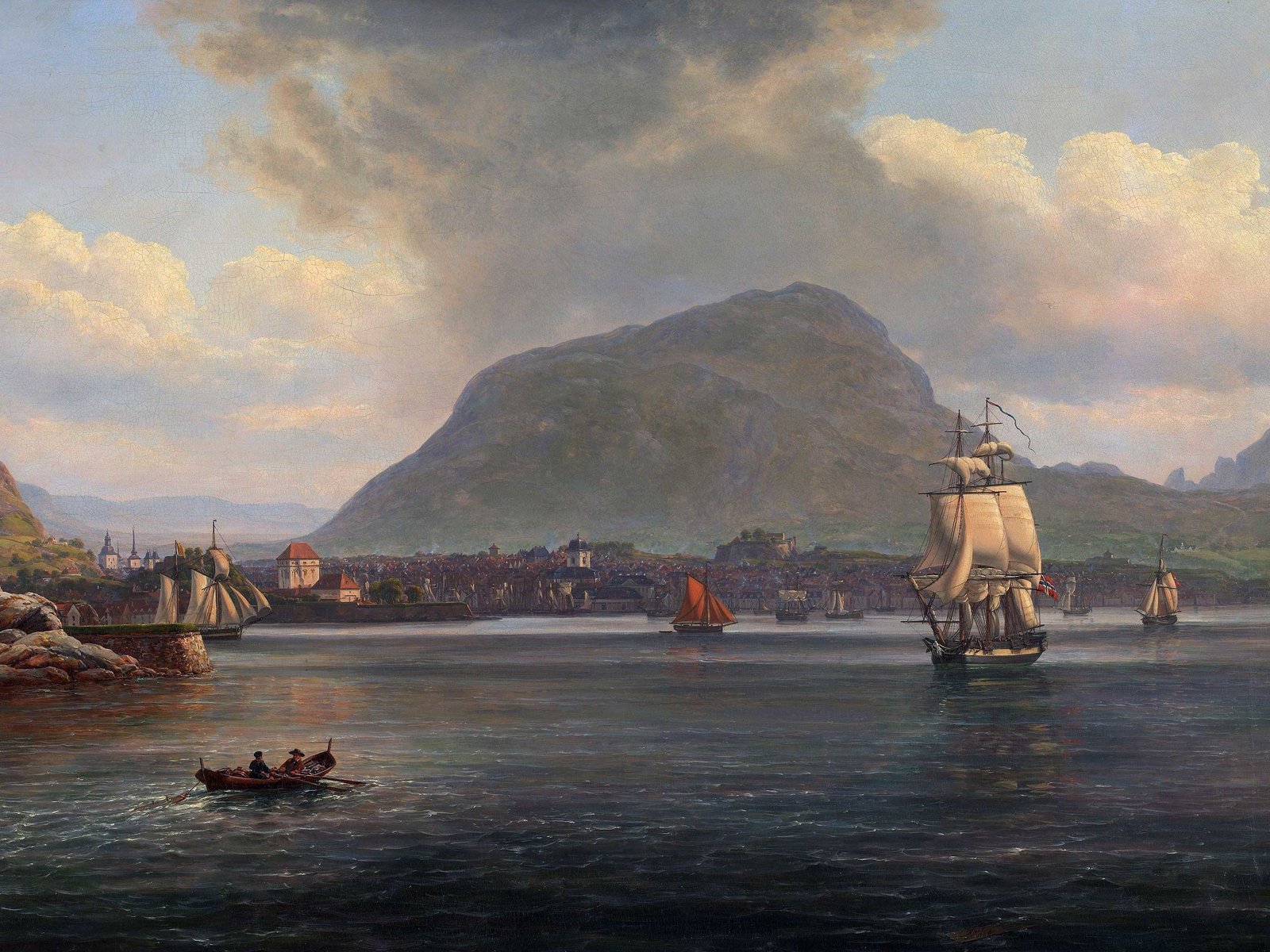Once Norway’s largest city
Historically, Bergen was known as Bjørgvin. It was Norway’s largest city throughout the Middle Ages – and up until as late as the 1830s.
To give you a perspective of the size of Norway’s and Bergen’s population, let us use Norway’s 1769-census as a reference point. At that time, Bergen had 13,735 inhabitants, out of a Norwegian total of 723,618.
Today, the city of Bergen has a population of about 300,000 – and is Norway’s second largest – after the capital, Oslo.
A historical trading hub
From the mid-1800s onwards – with the construction of roads and railways – the access to Norway’s inland regions improved significantly.
Prior to this time, boats were the primary means of transportation, leaving the inland regions more isolated.
Throughout history – prior to the building of roads and railways – trading hubs had developed all along Norway’s long-stretched coastline, and Bergen was the most significant of them all.
Not only was Bergen a centre for the surrounding inland regions, and a landing point for the local ocean fishers, but it was also the primary hub for Norway’s entire coastline traffic.
The Hanseatic League
From around AD 1350, and for the next 200 years, Bergen’s trade was dominated by the Hanseatic League, a North-European commercial and defence confederation of merchant guilds and market towns, with its centre in Northern Germany.
Now Norway’s main hub for import and export, Bergen became a melting pot of development and cultural influence. The famous Bryggen, a section of the city with old and characteristic wooden buildings and alleyways, has roots that stretch back to this historical period.
Archaeological excavations have discovered rich finds from Bergen’s earliest history. If you ever pay the city a visit, we recommend you check out the Bryggen Museum. The museum is also the starting point for guided tours, leading you through the historical sites.
Plundered and burned by pirates
Bergen was plundered and burned 4 times by a group called the Victual Brothers; later the Likedeelers.
The Likedeelers were mercenaries, privateers, and pirates operating in the Baltic and North seas.
The attacks on Bergen happened in AD 1393, 1428, 1429, and in 1432.
The worst attack took place in AD 1429, when the pirates attacked with 400 men and 7 ships. Later, 10 more ships joined them in the assault. The town was plundered and destroyed by fire.
Is it always raining in Bergen?
If you ask any Norwegian to mention 3 things they know about Bergen, we are certain that their first response will be: it rains a lot there. And they will be right: there are as many as 200 rainy days in Bergen per year.
This is the simplified explanation for the cause of all the rain: clouds come in towards Bergen from the ocean to the west, they hit the hills surrounding the city, then they are pushed up and hit colder temperatures, and down comes the rain.
But don’t let the rain stop you from visiting Bergen – this west Norwegian pearl of a city. Just make sure that you bring some wind and watertight clothes. Because, as the Norwegians say, there is no such thing as bad weather, just inadequate clothing.
Some Bergen notabilities
Edvard Grieg
The world-renowned composer Edvard Grieg (1843-1907) was born in Bergen. Today, his former home Troldhaugen is a museum, and his and his wife Nina’s ashes are entombed at the property. As a curiosity, we can mention that the family name Grieg once was Greig, and that Edvard was of Scottish descent.
Gerhard Armauer Hansen
Doctor Gerhard Armauer Hansen (1841-1912) discovered the bacteria that causes leprosy in 1873. Today, the disease is usually referred to as Hansen’s disease. When in Bergen, we recommend a visit to the Leprosy Museum, a monument to the suffering of many Norwegians.
Ludvig Holberg
By many, the writer Ludvig Holberg (1684-1754) is thought of as Danish. But – he was, in fact, born in Bergen and did not leave Norway until he was 18. His most known work is perhaps the play and comedy Jeppe on the Hill.
The southernmost port of the Hurtigruten cruise liners
Hurtigruten – meaning the fast route in Norwegian – started as a maritime passenger and freight link between Bergen and Norway’s far-north-eastern town of Kirkenes in the late 1800s.
The Hurtigruten ships have sailed along the Norwegian coast ever since, in all weathers, and have played a significant role in the survival of many of Norway’s coastal communities.
Today, the Hurtigruten is also a big player in the tourist market – showing off Norway’s magnificent coastline. And during the winter months, also the spectacular northern lights.
If you travel in summer, you might experience the thrill of seeing the midnight sun – when north of the Arctic Circle.
Hurtigruten also offers additional cruises to exotic destinations like Iceland, Svalbard, and Greenland.
When you are next in Norway
If you ever travel to Norway, we strongly recommend a visit to Bergen. We are certain that you won’t regret it.
Sources: Store Norske Leksikon snl.no. | Bergen byleksikon. | EGP.00056










